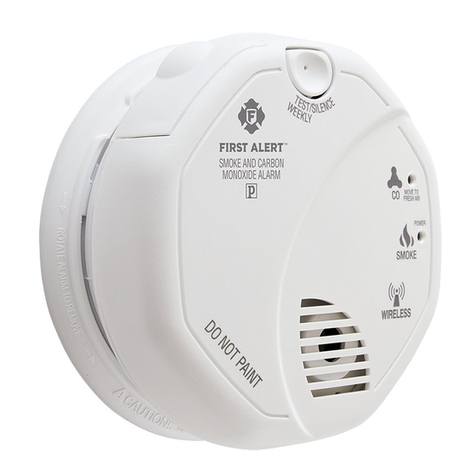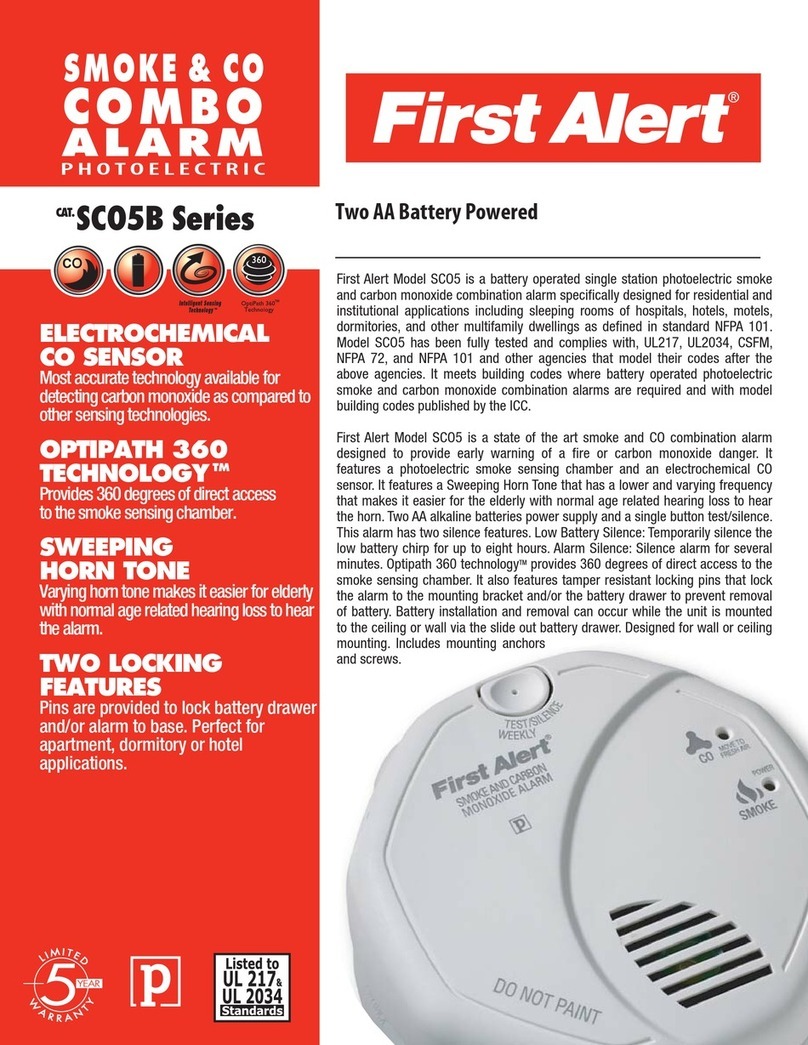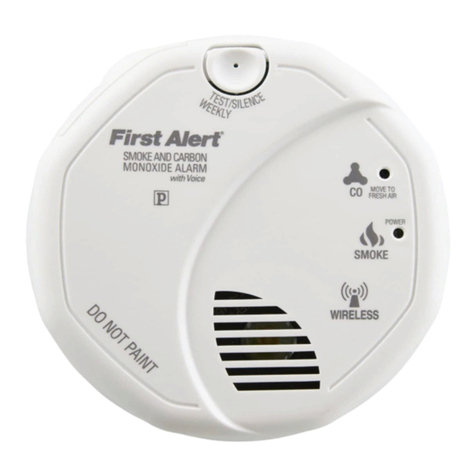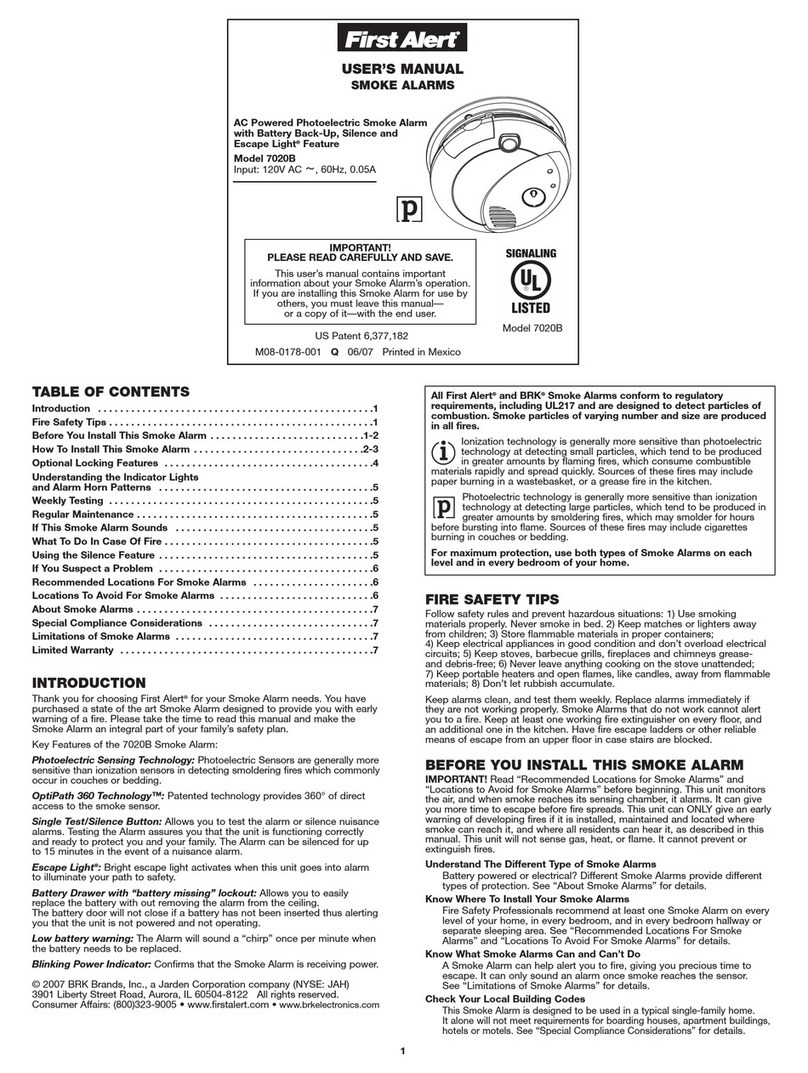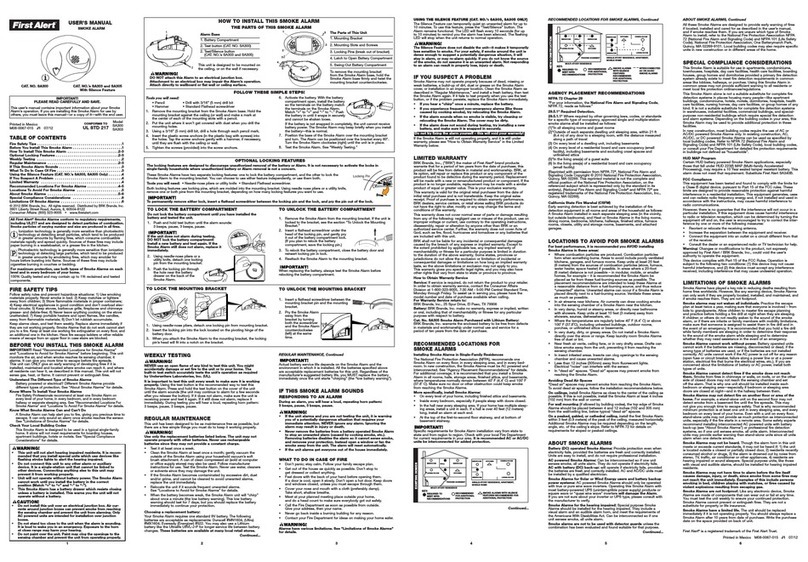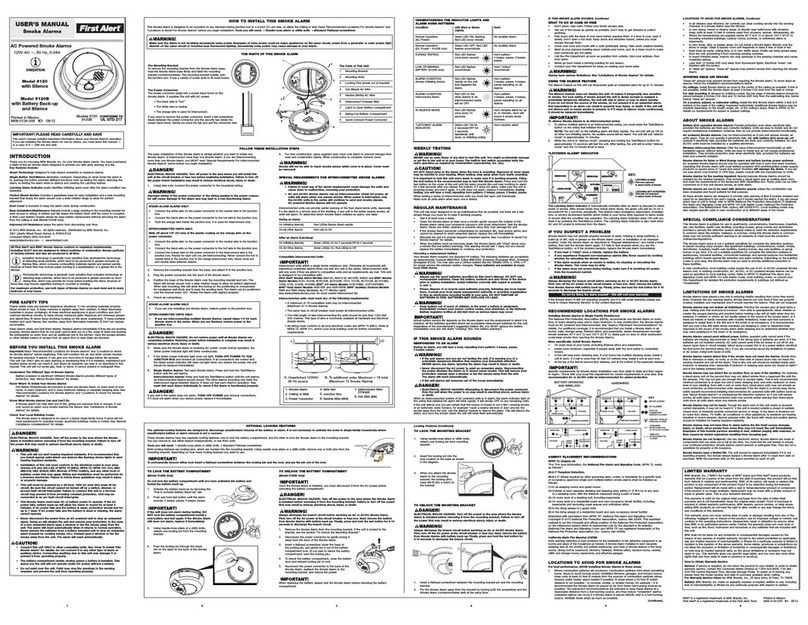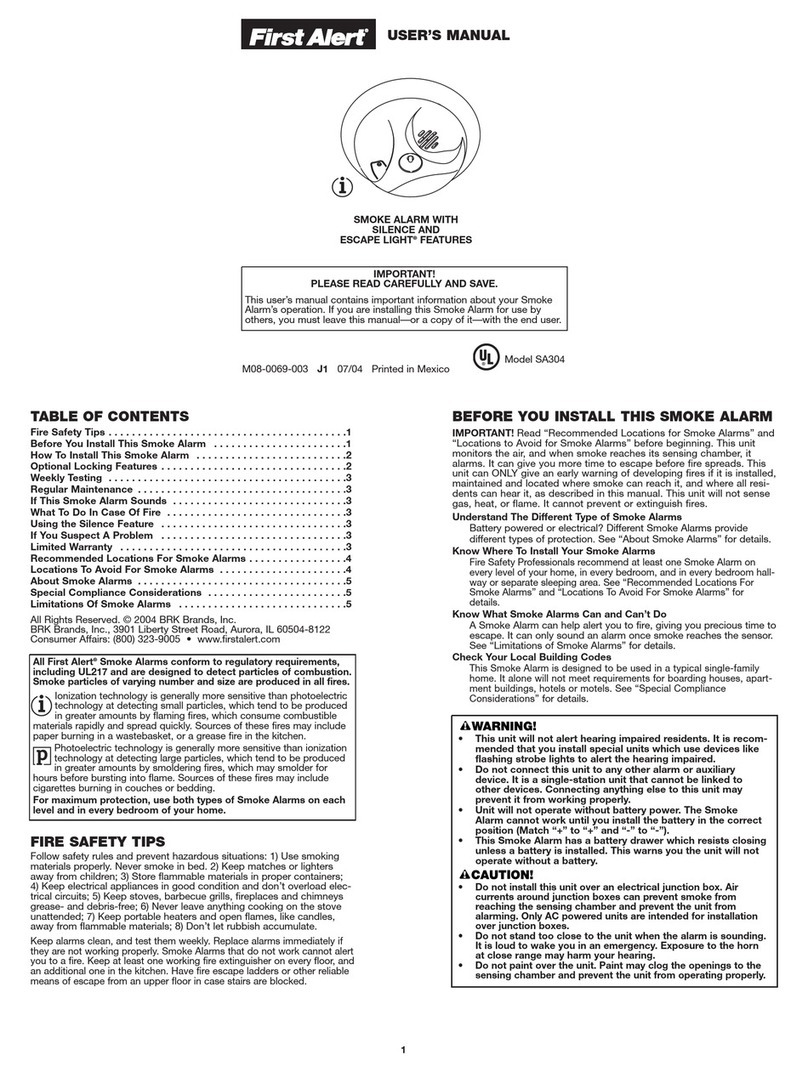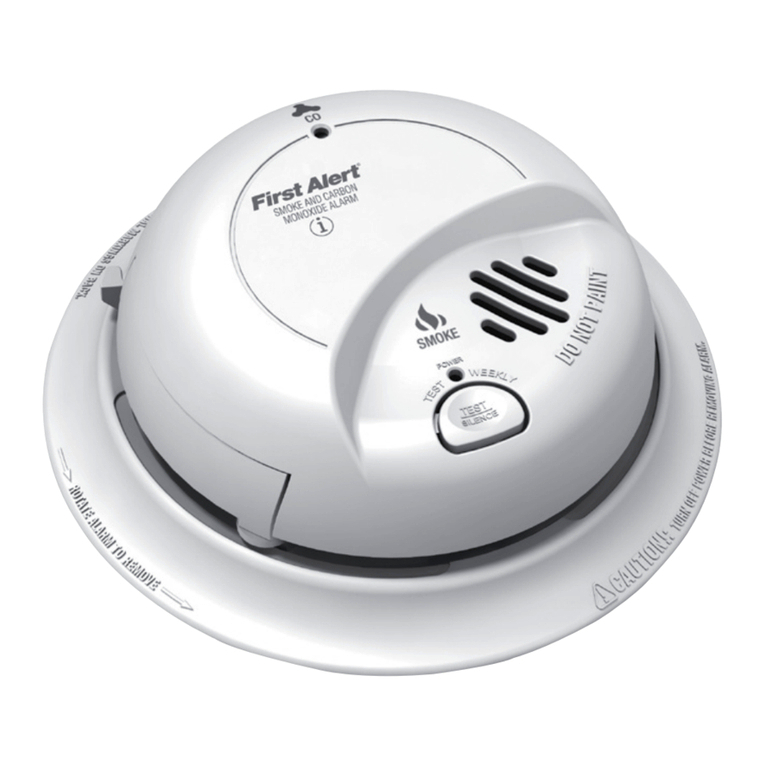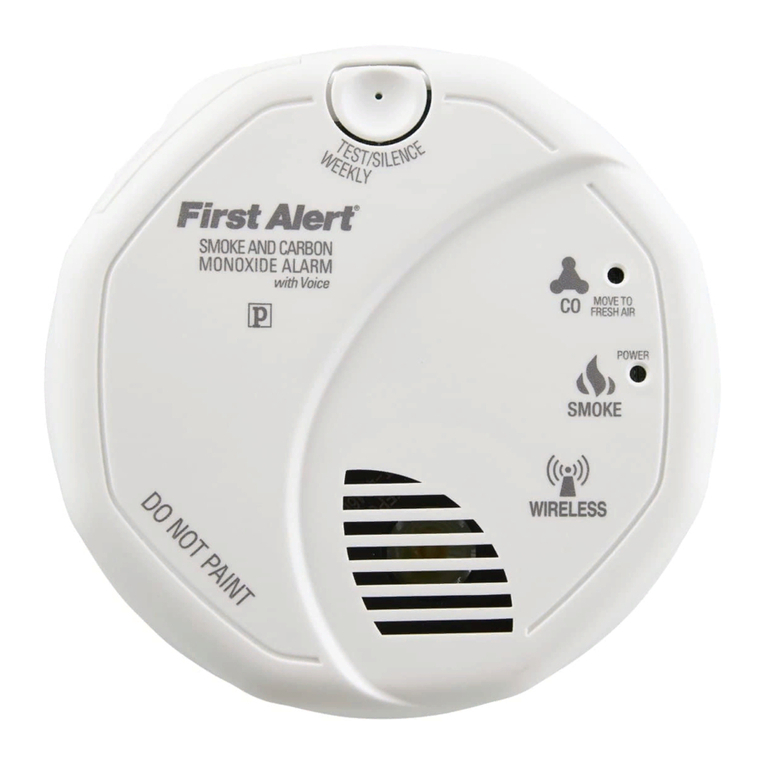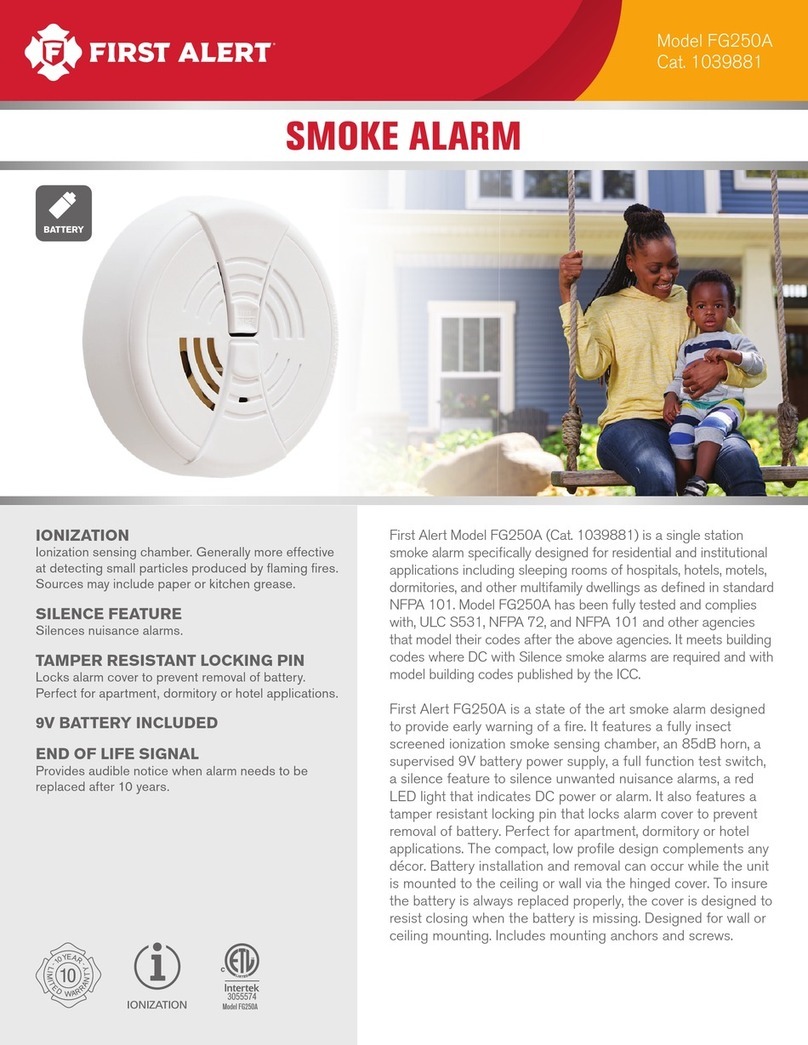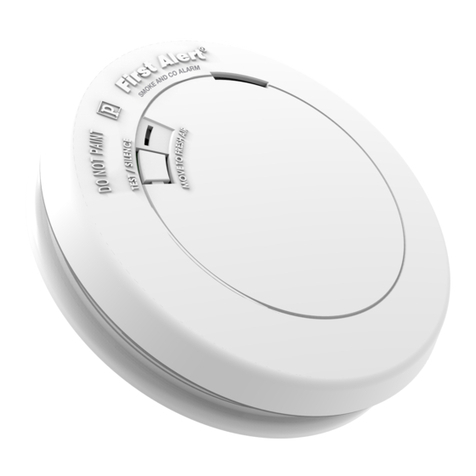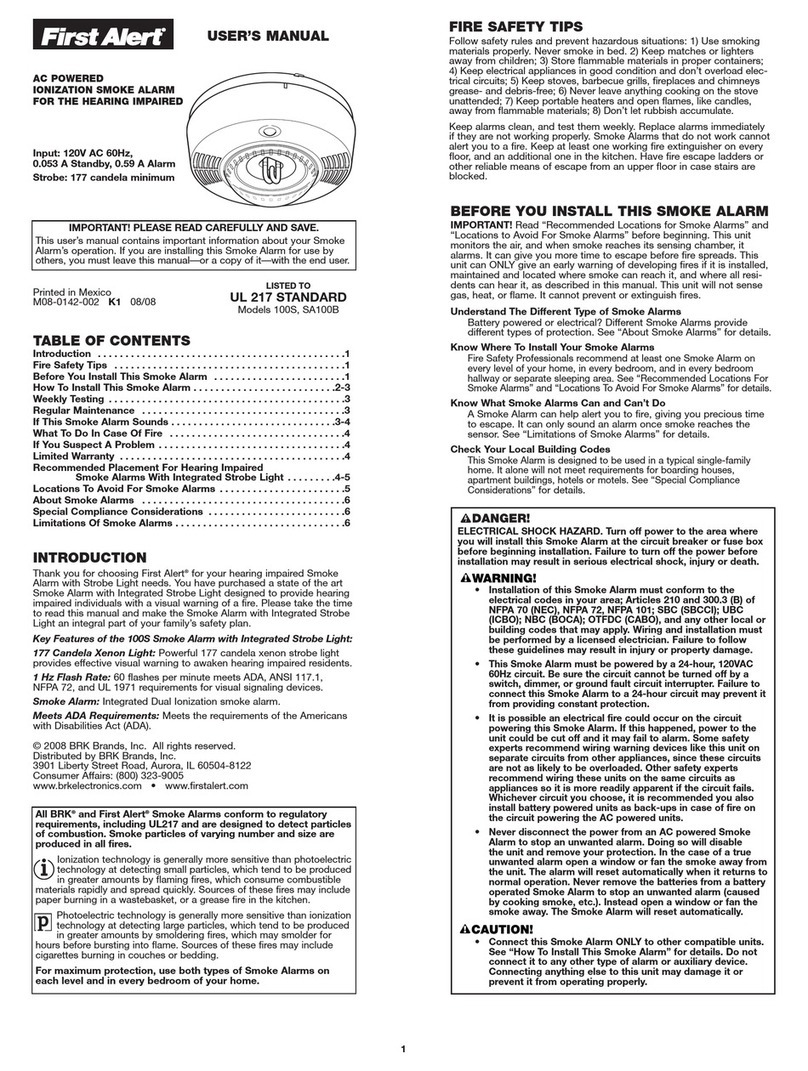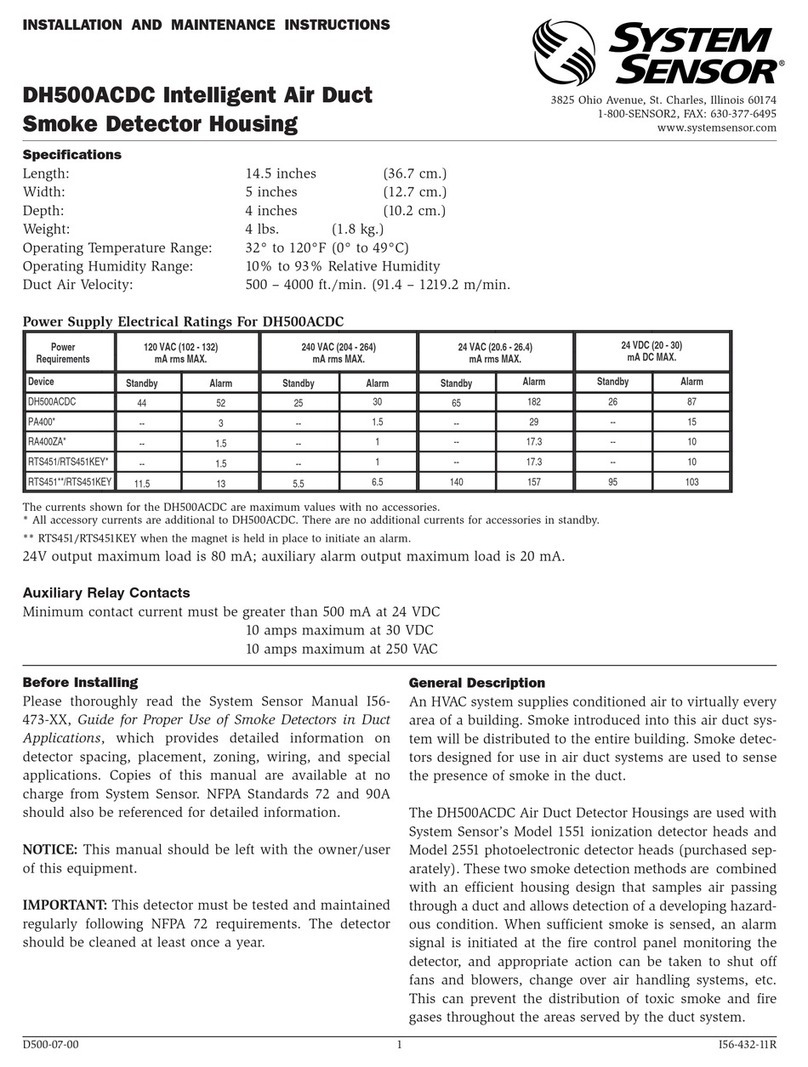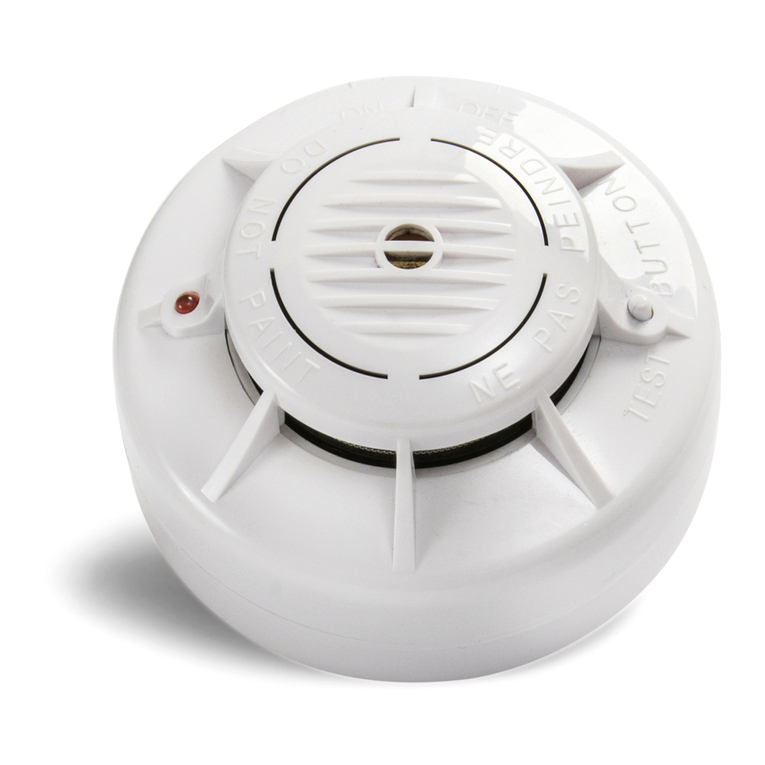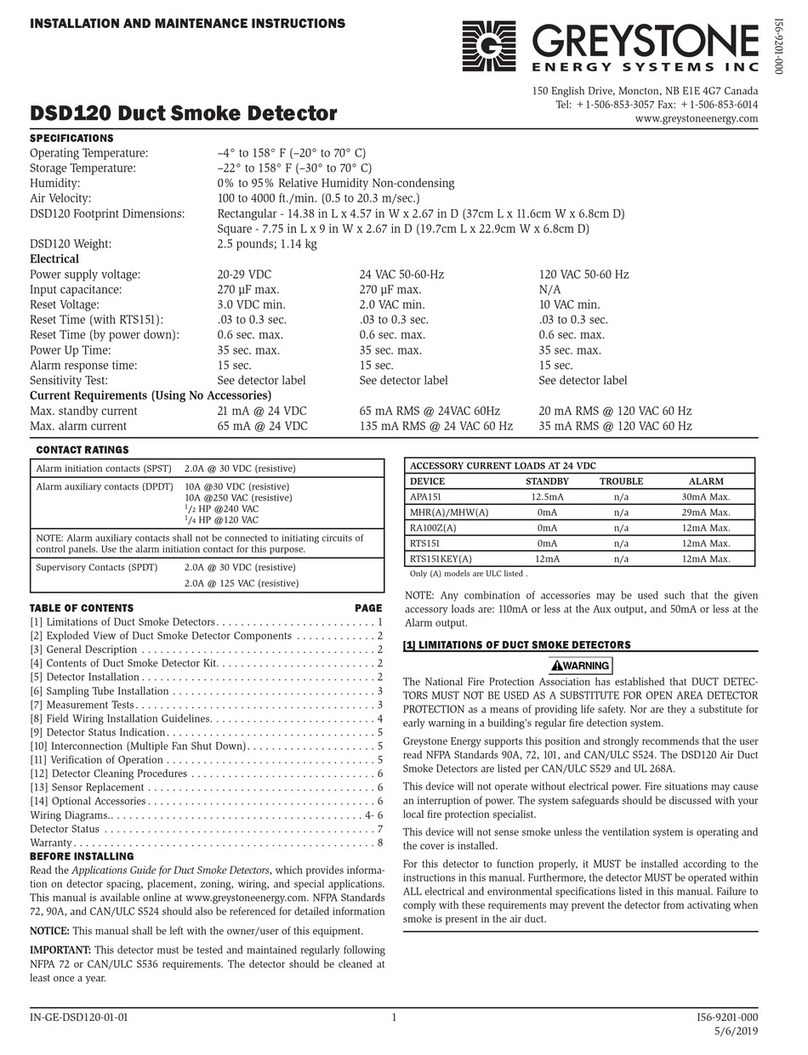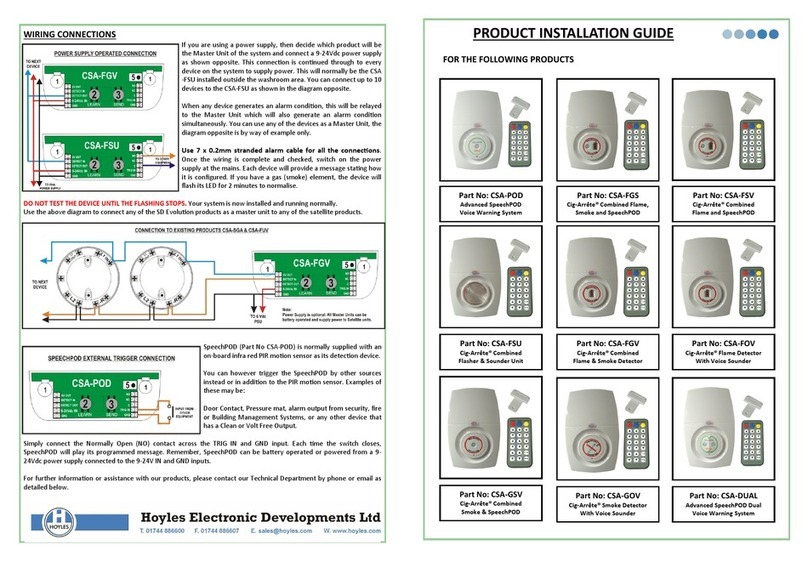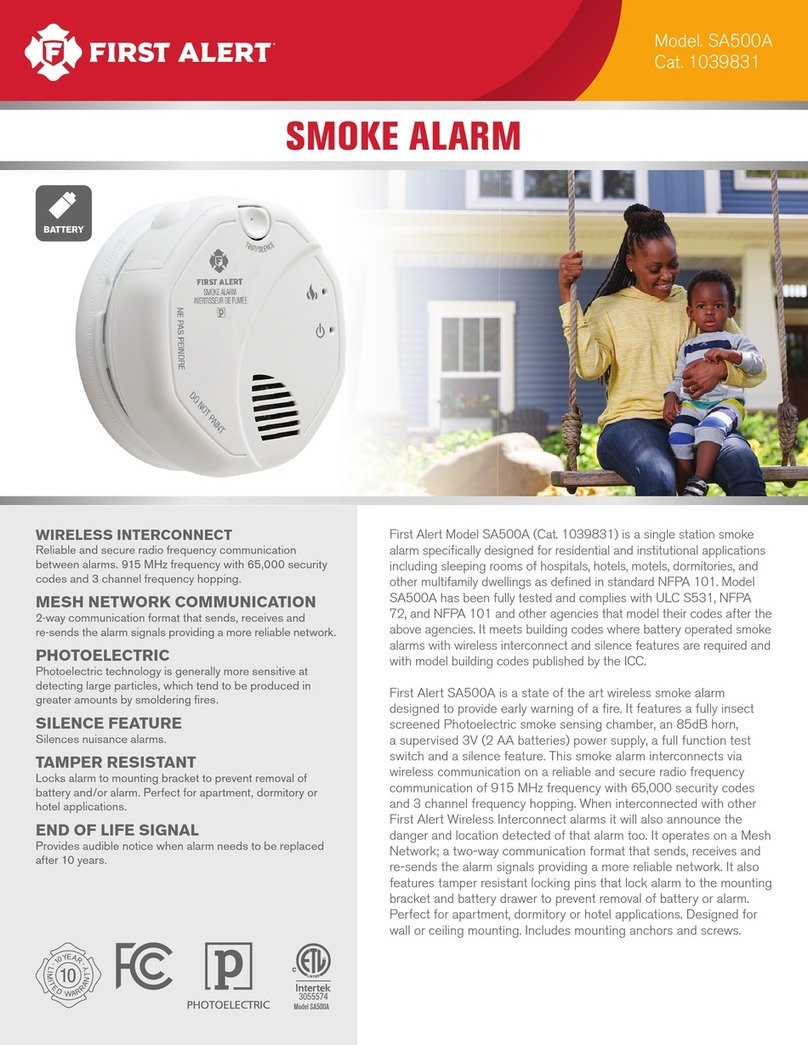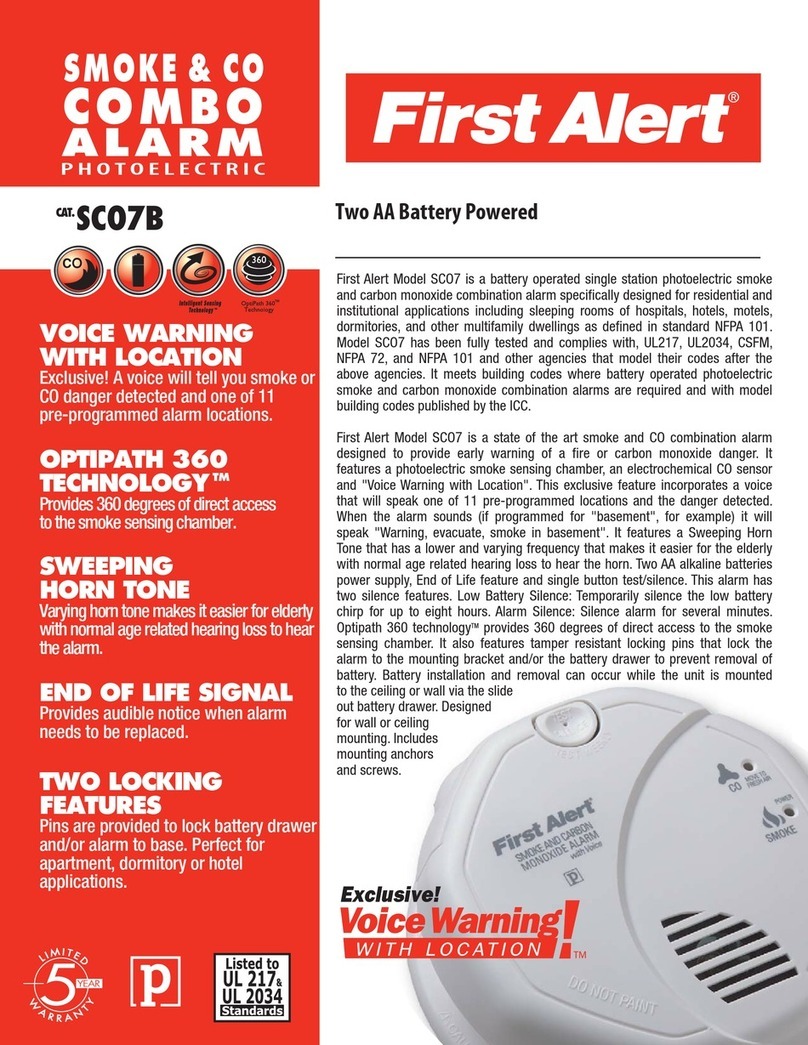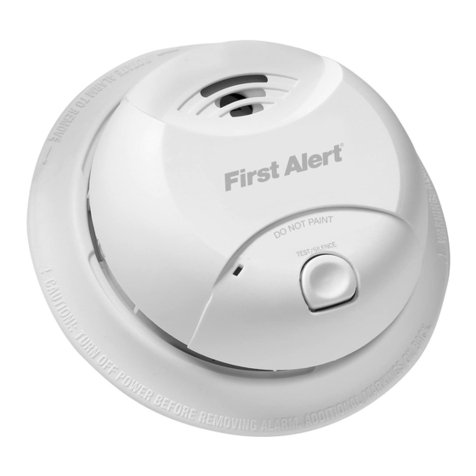Models 7010
7010B 7020B
Printed in Mexico
M08-0050-010 Q08/12
IMPORTANT! PLEASE READ CAREFULLY AND SAVE.
This user’s manual contains important information about your Smoke
Alarm’s operation. If you are installing this Smoke Alarm for use by
others you must leave this manual—or a copy of it—with the end user.
INTRODUCTION
Thank you for choosing First Alert®for your Smoke Alarm needs. You have
purchased a state of the art Smoke Alarm designed to provide you with an
early warning of a fire. Please take the time to read this manual and make
this Smoke Alarm an integral part of your family’s safety plan.
Key Features of the 7010, 7010B and 7020B Smoke A arms:
Photoe ectric Smoke Sensing Techno ogy: Generally more sensitive at
detecting large particles which tend to be produced in greater amounts by
smoldering fires.
Optipath 360 Techno ogyTM:Patented technology provides 360˚ of direct
access to the smoke sensor.
Sing e Button Test/Si ence: One touch button combines both features.
Aarm Latch: Remembers which unit initiated an alarm.
Perfect Mount: Mounting bracket keeps alarm secure over a wide rotation
range to allow for perfect alignment.
Battery back-up (Mode s 7010B and 7020B on y): Keeps alarm functioning
during a power interruption provided battery is fresh and installed properly.
Escape Light®(Mode 7020B on y): Bright escape light activates when this
unit goes into alarm to illuminate your path to safety.
© 2012 BRK Brands Inc. All rights reserved. Distributed by BRK Brands Inc.
3901 Liberty Street Road Aurora IL 60504-8122
Consumer Affairs: (800) 323-9005
www.firstalert.com • www.brkelectronics.com
FIRE SAFETY TIPS
Follow safety rules and prevent hazardous situations: 1) Use smoking
materials properly. Never smoke in bed. 2) Keep matches or lighters away
from children; 3) Store flammable materials in proper containers;
4) Keep electrical appliances in good condition and don’t overload electrical
circuits; 5) Keep stoves barbecue grills fireplaces and chimneys grease-
and debris-free; 6) Never leave anything cooking on the stove unattended;
7) Keep portable heaters and open flames like candles away from flammable
materials; 8) Don’t let rubbish accumulate.
Keep alarms clean and test them weekly. Replace alarms immediately if they
are not working properly. Smoke Alarms that do not work cannot alert you to a
fire. Keep at least one working fire extinguisher on every floor and an additional
one in the kitchen. Have fire escape ladders or other reliable means of escape
from an upper floor in case stairs are blocked.
BEFORE YOU INSTALL THIS SMOKE ALARM
IMPORTANT! Read “Recommended Locations for Smoke Alarms” and
“Locations to Avoid for Smoke Alarms” before beginning. This unit monitors
the air and when smoke reaches its sensing chamber it alarms. It can give
you more time to escape before fire spreads. This unit can ONLY give an early
warning of developing fires if it is installed maintained and located where
smoke can reach it and where all residents can hear it as described in this
manual. This unit will not sense gas heat or flame. It cannot prevent or
extinguish fires.
Un erstan The Different Type of Smoke Alarms
Battery powered or electrical? Different Smoke Alarms provide different
types of protection. See “About Smoke Alarms” for details.
Know Where To Install Your Smoke Alarms
Fire Safety Professionals recommend at least one Smoke Alarm on every
level of your home in every bedroom and in every bedroom hallway or
separate sleeping area. See “Recommended Locations For Smoke Alarms”
and “Locations To Avoid For Smoke Alarms” for details.
Know What Smoke Alarms Can an Can’t Do
A Smoke Alarm can help alert you to fire giving you precious time to
escape. It can only sound an alarm once smoke reaches the sensor.
See “Limitations of Smoke Alarms” for details.
Check Your Local Buil ing Co es
This Smoke Alarm is designed to be used in a typical single-family home.
It alone will not meet requirements for boarding houses apartment
buildings hotels or motels. See “Special Compliance Considerations”
for details.
1 2 3
All First Alert®an BRK®Smoke Alarms conform to regulatory
requirements, inclu ing UL217 an are esigne to etect particles of
combustion. Smoke particles of varying number an size are pro uce
in all fires.
Ionization technology is generally more sensitive than photoelectric
technology at detecting small particles which tend to be produced
in greater amounts by flaming fires which consume combustible
materials rapidly and spread quickly. Sources of these fires may include
paper burning in a wastebasket or a grease fire in the kitchen.
Photoelectric technology is generally more sensitive than ionization
technology at detecting large particles which tend to be produced in
greater amounts by smoldering fires which may smolder for hours
before bursting into flame. Sources of these fires may include cigarettes
burning in couches or bedding.
For maximum protection, use both types of Smoke Alarms on each
level an in every be room of your home.
USER’S MANUAL
SMOKE ALARMS
ELECTRICAL SHOCK HAZARD. Turn off the power to the area where the
Smoke Alarm is installe before removing it from the mounting bracket.
Failure to turn off the power first may result in serious electrical shock,
injury or eath.
• This unit will not alert hearing impaire resi ents. It is recom-
men e that you install special units which use evices like
flashing strobe lights to alert hearing impaire resi ents.
• Installation of this unit must conform to the electrical co es in
your area; Articles 210 an 300.3 (B) of NFPA 70 (NEC), NFPA 72,
NFPA 101; SBC (SBCCI); UBC (ICBO); NBC (BOCA); OTFDC (CABO),
an any other local or buil ing co es that may apply. Wiring an
installation must be performe by a license electrician. Failure to
follow these gui elines may result in injury or property amage.
• This unit must be powere by a 24-hour, 120VAC pure sine wave
60Hz circuit. Be sure the circuit cannot be turne off by a switch,
immer, or groun fault circuit interrupter. Failure to connect this
unit to a 24-hour circuit may prevent it from provi ing constant
protection.
• This Smoke Alarm must have AC or battery power to operate.
On Mo els 7010B an 7020B Only:
If the AC power fails, battery back-up will allow the alarm to
soun for at least 4 minutes. If AC power fails an the battery is
weak, protection shoul last for at least 7 ays. If AC power fails
an the battery is ea or missing, the alarm cannot operate.
• Never isconnect the power from an AC powere unit to stop an
unwante alarm. Doing so will isable the unit an remove your
protection. In the case of a true unwante alarm open a win ow
or fan the smoke away from the unit. The alarm will reset auto-
matically when it returns to normal operation. Never remove the
batteries from a battery operate unit to stop an unwante alarm
(cause by cooking smoke, etc.). Instea open a win ow or fan
the smoke away from the unit. The alarm will reset automatically.
• Connect this unit ONLY to other compatible units. See “How To
Install This Smoke Alarm” for etails. Do not connect it to any
other type of alarm or auxiliary evice. Connecting anything else
to this unit may amage it or prevent it from operating properly.
• On Mo els 7010B/7020B Only: This Smoke Alarm has a battery
rawer which resists closing unless a battery is installe . This
warns you the unit will not operate un er DC power without a
battery.
• Do not stan too close to the unit when the alarm is soun ing.
It is lou to wake you in an emergency. Exposure to the horn at
close range may harm your hearing.
• Do not paint over the unit. Paint may clog the openings to the
sensing chambers an prevent the unit from operating properly.
The Mounting Bracket:
To remove the mounting bracket from the Smoke
Alarm base hold the Smoke Alarm base firmly
and twist the mounting bracket counterclockwise.
The mounting bracket installs onto the junction box.
It has a variety of screw slots to fit most boxes.
The Power Connector:
The power connector plugs into a power input block on
the Smoke Alarm. It supplies the unit with AC power.
• The black wire is “hot.”
• The white wire is neutral.
• The orange wire is used for interconnect.
If you nee to remove the power connector, turn
POWER OFF first. Insert a flat screwdriver blade
between the power connector and the security tab
inside the power input block. Gently pry back the tab
and pull the connector free.
A. Unswitched 120VAC
60 Hz source
B. To additional units; Maximum = 18 total
(Maximum 12 Smoke Alarms)
1. Smoke Alarm
2. Ceiling or Wall
3. Power Connector
4. Wire Nut
5. Junction Box
6. Neutral Wire (Wht)
7. Interconnect Wire
(Orange)
8. Hot Wire (Blk)
4
OPTIONAL LOCKING FEATURES
The locking features are esigne to iscourage unauthorize removal of the battery or Alarm. It is not necessary to activate the locks in single-family
househol s where unauthorize battery or Alarm removal is not a concern.
These Smoke Alarms have two separate locking features: one to lock the battery compartment and the other to lock the Smoke Alarm
to the mounting bracket. You can choose to use either feature independently or use them both.
Tools you will nee : • Needle-nose pliers or utility knife • Standard Flathead screwdriver.
Both locking features use locking pins which are molded into the mounting bracket. Using needle-nose pliers or a utility knife remove
one or both pins from the mounting bracket depending on how many locking features you want to use.
To permanently remove either lock, insert a flathea screw river between the locking pin an the lock, an pry the pin out of the lock.
TO LOCK THE BATTERY COMPARTMENT
(Mo els 7010B an 7020B Only)
Do not lock the battery compartment until you have installe the
battery an teste the battery back-up.
1. Push and hold Test button until the alarm sounds: 3 beeps pause
3 beeps pause. The Escape Light®will turn on (Model 7020B only).
LED flashes once every second.
If the unit oes not alarm uring testing, DO NOT lock the battery
compartment! Install a new battery an test again. If the Smoke
Alarm still oes not alarm, replace it imme iately.
2. Using needle-nose pliers or a utility knife detach one locking pin
from the mounting bracket.
3. Push the locking pin through the hole near the battery drawer on the
back of the Smoke Alarm.
TO UNLOCK THE BATTERY COMPARTMENT
(Mo el 7010B an 7020B Only)
Once the Smoke Alarm is installed you must disconnect it from the AC power
before unlocking the battery compartment.
ELECTRICAL SHOCK HAZARD. Turn off the power to the area where the
Smoke Alarm is installe before removing it from the mounting bracket.
Failure to turn off the power first may result in serious electrical shock,
injury or eath.
Always ischarge the branch circuit before servicing an AC or AC/DC
Smoke Alarm. First, turn off the AC power at the circuit breaker or fuse box.
Next, remove the battery from Smoke Alarms with battery back-up. Finally,
press an hol the Test/Silence button for 5-10 secon s to ischarge the
branch circuit.
1. Remove the Smoke Alarm from the mounting
bracket. If the unit is locked to the bracket see
the section “To Unlock the Mounting Bracket.”
2. Disconnect the power connector by gently prying
it away from the back of the Smoke Alarm.
3. Insert a flathead screwdriver under the head
of the locking pin and gently pry it out of the
battery compartment lock. (If you plan to relock
the battery compartment save the locking pin.)
4. To relock the battery compartment close the battery door and reinsert
locking pin in lock.
5. Reconnect the power connector to the back of the Smoke Alarm reattach
the Smoke Alarm to the mounting bracket and restore the power.
When replacing the battery always test the Smoke Alarm before relocking the
battery compartment.
TO UNLOCK THE MOUNTING BRACKET
ELECTRICAL SHOCK HAZARD. Turn off the power to the area where the
Smoke Alarm is installe before removing it from the mounting bracket.
Failure to turn off the power first may result in serious electrical shock,
injury or eath.
Always ischarge the branch circuit before servicing an AC or AC/DC
Smoke Alarm. First, turn off the AC power at the circuit breaker or fuse
box. Next, remove the battery from Smoke Alarms with battery back-up.
Finally, press an hol the Test/Silence button for 5-10 secon s to
ischarge the branch circuit.
1. Insert a flathead screwdriver between the
mounting bracket pin and the mounting bracket.
2. Pry the Smoke Alarm away from the bracket by
turning both the screwdriver and the Smoke
Alarm counterclockwise (left) at the same time.
TO LOCK THE MOUNTING BRACKET
1. Using needle-nose pliers detach one locking pin from mounting bracket.
2. Insert the locking pin into the lock located
opposite from the battery drawer as shown
in the diagram.
3. When you attach the Smoke Alarm to the mounting bracket the locking
pin’s head will fit into a notch on the bracket.
Locking Features (Continued)
WEEKLY TESTING
•NEVER use an open flame of any kin to test this unit. You might
acci entally amage or set fire to the unit or to your home. The built-
in test switch accurately tests the unit’s operation as require by
Un erwriters Laboratories, Inc. (UL).
•If the Alarm ever fails to test properly, replace it imme iately.
Pro ucts un er warranty may be returne to the manufacturer
for replacement. See “Limite Warranty” at the en of this manual.
DO NOT stan close to the Alarm when the horn is soun ing. Exposure
at close range may be harmful to your hearing. When testing, step away
when horn starts soun ing.
It is important to test this unit every week to make sure it is working
properly. Using the test button is the recommen e way to test this
Smoke Alarm. Press and hold the Test/Silence button on the cover of the
unit until the alarm sounds and the Escape Light®turns on (Model 7020B
only) (the unit may continue to alarm for a few seconds after you release the
button). If it does not alarm make sure the unit is receiving power and test it
again. If it still does not alarm replace it immediately. During testing, you
will hear a lou , repeating horn pattern: 3 beeps, pause, 3 beeps, pause.
The Escape Light®will turn on (Mo el 7020B only). LED flashes once
every secon . When powered by AC only Escape Light®will not activate.
The Escape Light®feature works only when powered by DC or AC/DC.
When testing a series of interconnected units you must test each unit
individually. Make sure all units alarm when each one is tested.
REGULAR MAINTENANCE
This unit has been designed to be as maintenance-free as possible but there
are a few simple things you must do to keep it working properly:
•Test it at least once a week.
•Clean the Smoke Alarm at least once a month; gently vacuum the
outside of the Smoke Alarm using your household vacuum’s soft brush
attachment. Test the Smoke Alarm. Never use water cleaners or solvents
since they may damage the unit.
• If the Smoke Alarm becomes contaminated by excessive dirt dust and/or
grime and cannot be cleaned to avoid unwanted alarms replace the
unit immediately.
• Relocate the unit if it sounds frequent unwanted alarms. See “Locations
To Avoid For Smoke Alarms” for details.
•Mo els 7010B an 7020B Only: When the battery back-up becomes
weak the Smoke Alarm will “chirp” about once a minute (the low battery
warning). This warning should last 7 days but you should replace the
battery immediately to continue your protection.
Mo els 7010B an 7020B Only
–
Choosing a replacement battery:
Your Smoke Alarm requires one standard 9V battery. The following batteries
are acceptable as replacements: Eveready #1222 Duracell #MN1604
(Ultra) #MX1604; Eveready (Energizer) #522. You may also use a Lithium
battery like the Ultralife U9VL-J U9VL-J-P for longer service life between
battery changes. These batteries are available at many local retail stores.
•Always use the exact batteries specifie by this User’s Manual.
DO NOT use rechargeable batteries. Clean the battery contacts an
also those of the evice prior to battery installation. Install batteries
correctly with regar to polarity (+ an -).
•Please ispose of or recycle use batteries properly, following any
local regulations. Consult your local waste management authority
or recycling organization to fin an electronics recycling facility in
your area. DO NOT DISPOSE OF BATTERIES IN FIRE. BATTERIES
MAY EXPLODE OR LEAK.
UNDERSTANDING THE INDICATOR LIGHTS
AND ALARM HORN PATTERNS
NOTE: When power is applie , unit(s) may alarm momentarily.
*When any Smoke Alarm in an interconnected series triggers an alarm its
red LED will flash rapidly. The red LEDs will remain OFF on any remaining
alarms in the series. This feature helps responders identify which unit(s)
triggered the alarm.
Alarm Latch Red LED will flash 3
times spaced one
second apart.
Pattern repeats
once/minute
Not Applicable
AC Power
All Mo els
DC Power
Mo els 7010B/7020B
Normal Operation Constant Green LED
Flashing Red LED
approx. once/minute
No Audible Alarm
Green LED Off
Flashing Red LED
approx. once/minute
No Audible Alarm
Test Con ition Constant Green LED
Rapidly Flashing
Red LED
Audible Alarm
Escape Light®On
(Model 7020B only)
Green LED Off
Rapidly Flashing
Red LED
Audible Alarm
Escape Light®On
(Model 7020B only)
Malfunction Horn sounds 3 chirps
Pattern repeats
once/minute
Horn sounds 3 chirps
Pattern repeats
once/minute
Alarm Con ition*
(Initiating Unit) Constant Green LED
Rapidly Flashing
Red LED
Audible Alarm
Escape Light®On
(Model 7020B only)
Green LED Off
Rapidly Flashing
Red LED
Audible Alarm
Escape Light®On
(Model 7020B only)
Silence Mo e Red LED flashes once
every 10 seconds Red LED flashes once
every 10 seconds
Model 7010
with Silence
Model 7010B
with Battery Back-Up an Silence
Model 7020B
with Battery Back-Up, Silence
an Escape Light®Feature
AC Powere Photoelectric Smoke Alarms
Input: 120V AC ~ 60Hz 0.05A Make sure the Alarm is not receiving excessively noisy power. Examples of noisy power coul be major appliances on the same circuit, power from a
generator or solar power, light immer on the same circuit or mounte near fluorescent lighting. Excessively noisy power may cause amage to your
Alarm.
Low Battery Alarm “chirp’’ approx.
once/minute
(Not Applicable to
Model 7010)
Alarm “chirp’’ approx.
once/minute
CONFORMS TO
UL STD 217
6 7
Printed in Mexico M08-0050-010 Q08/12
AGENCY PLACEMENT RECOMMENDATIONS
NFPA 72 Chapter 29
“For your information the National Fire Alarm an Signaling Co e NFPA 72
reads as follows:”
29.5.1* Require Detection.
29.5.1.1* Where required by other governing laws codes or standards for a
specific type of occupancy approved single and multiple-station smoke
alarms shall be installed as follows:
(1)*In all sleeping rooms and guest rooms
(2)*Outside of each separate dwelling unit sleeping area within 21 ft (6.4 m)
of any door to a sleeping room with the distance measured along a path
of travel
(3) On every level of a dwelling unit including basements
(4) On every level of a residential board and care occupancy (small facility)
including basements and excluding crawl spaces and unfinished attics
(5)*In the living area(s) of a guest suite
(6) In the living area(s) of a residential board and care occupancy
(small facility)
(Reprinted with permission from NFPA 72® National Fire Alarm and Signaling
Code Copyright © 2010 National Fire Protection Association Quincy MA 02269.
This reprinted material is not the complete and official position of the National
Fire Protection Association on the referenced subject which is represented
only by the standard in its entirety) (National Fire Alarm and Signaling Code®
and NFPA 72®are registered trademarks of the National Fire Protection
Association Inc. Quincy MA 02269).
California State Fire Marshal (CSFM)
Early warning detection is best achieved by the installation of fire detection
equipment in all rooms and areas of the household as follows: A Smoke Alarm
installed in each separate sleeping area (in the vicinity but outside bedrooms)
and Heat or Smoke Alarms in the living rooms dining rooms bedrooms
kitchens hallways finished attics furnace rooms closets utility and storage
rooms basements and attached garages.
LOCATIONS TO AVOID FOR SMOKE ALARMS
For best performance, AVOID installing Smoke Alarms in these areas:
• Where combustion particles are produced. Combustion particles form
when something burns. Areas to avoid include poorly ventilated kitchens
garages and furnace rooms. Keep units at least 20 feet (6 meters) from
the sources of combustion particles (stove furnace water heater space
heater) if possible. In areas where a 20-foot distance is not possible – in
modular mobile or smaller homes for example – it is recommended
the Smoke Alarm be placed as far from these fuel-burning sources as
possible. The placement recommendations are intended to keep these
Alarms at a reasonable distance from a fuel-burning source and thus
reduce “unwanted” alarms. Unwanted alarms can occur if a Smoke Alarm
is placed directly next to a fuel-burning source. Ventilate these areas as
much as possible.
• In air streams near kitchens. Air currents can draw cooking smoke into
the sensing chamber of a Smoke Alarm near the kitchen.
• In very damp humid or steamy areas or directly near bathrooms with
showers. Keep units at least 10 feet (3 meters) away from showers
saunas dishwashers etc.
• Where the temperatures are regularly below 40˚ F (4.4˚ C) or above 100˚ F
(37.8˚ C) including unheated buildings outdoor rooms porches or
unfinished attics or basements.
•In very dusty dirty or greasy areas. Do not install a Smoke Alarm directly
over the stove or range. Clean a laundry room unit frequently to keep it
free of dust or lint.
•Near fresh air vents ceiling fans or in very drafty areas. Drafts can blow
smoke away from the unit preventing it from reaching sensing chamber.
•In insect infested areas. Insects can clog openings to the sensing chamber
and cause unwanted alarms.
• Less than 12 inches (305 mm) away from fluorescent lights. Electrical
“noise” can interfere with the sensor.
• In “dead air” spaces. “Dead air” spaces may prevent smoke from reaching
the Smoke Alarm.
AVOIDING DEAD AIR SPACES
“Dead air” spaces may prevent smoke from reaching the Smoke Alarm.
To avoid dead air spaces follow the installation recommendations below.
On ceilings, install Smoke Alarms as close to the center of the ceiling as
possible. If this is not possible install the Smoke Alarm at least 4 inches
(102 mm) from the wall or corner.
For wall mounting (if allowed by building codes) the top edge of Smoke
Alarms should be placed between 4 inches (102 mm) and 12 inches (305 mm)
from the wall/ceiling line below typical “dead air” spaces.
On a peake , gable , or cathe ral ceiling, install the first Smoke Alarm
within 3 feet (0.9 meters) of the peak of the ceiling measured horizontally.
Additional Smoke Alarms may be required depending on the length angle
etc. of the ceiling's slope. Refer to NFPA 72 for details on requirements for
sloped or peaked ceilings.
ABOUT SMOKE ALARMS
Battery (DC) operate Smoke Alarms: Provide protection even when
electricity fails provided the batteries are fresh and correctly installed. Units
are easy to install and do not require professional installation. They do not
however provide interconnected functionality.
AC powere Smoke Alarms: Can be interconnected so if one unit senses
smoke all units alarm. They do not operate if electricity fails.
AC with battery (DC) back-up: will operate if electricity fails provided the
batteries are fresh and correctly installed. AC and AC/DC units must be
installed by a qualified electrician.
Wireless Interconnecte Alarms: Offer the same interconnected functionality
as with hardwired alarms without wires. Units are easy to install and do not
require professional installation. They provide protection even when electricity
fails provided the batteries are fresh and correctly installed.
Smoke Alarms for Solar or Win Energy users an battery backup power
systems: AC powered Smoke Alarms should only be operated with true or
pure sine wave inverters. Operating this Smoke Alarm with most battery-
powered UPS (uninterruptible power supply) products or square wave or
“quasi sine wave” inverters will amage the Alarm. If you are not sure about
your inverter or UPS type please consult with the manufacturer to verify.
Smoke Alarms for the hearing impaire : Special purpose Smoke Alarms
should be installed for the hearing impaired. They include a visual alarm and
an audible alarm horn and meet the requirements of the Americans With
Disabilities Act. These units can be interconnected so if one unit senses
smoke all units alarm.
Smoke alarms are not to be use with etector guar s unless the
combination has been evaluated and found suitable for that purpose.
All these Smoke Alarms are designed to provide early warning of fires if
located installed and cared for as described in the user’s manual and if
smoke reaches the Alarm. If you are unsure which type of unit to install refer
to NFPA (National Fire Protection Association) 72 (National Fire Alarm and
Signaling Code) and NFPA 101 (Life Safety Code). National Fire Protection
Association One Batterymarch Park Quincy MA 02269-9101. Local building
codes may also require specific units in new construction or in different areas
of the home.
RECOMMENDED LOCATIONS FOR SMOKE ALARMS, Continued
Specific requirements for Smoke Alarm installation vary from state to state
and from region to region. Check with your local Fire Department for current
requirements in your area. It is recommen e AC or AC/DC units be inter-
connecte for a e protection.
5
IF THIS SMOKE ALARM SOUNDS
RESPONDING TO AN ALARM
During an alarm, you will hear a lou , repeating horn pattern: 3 beeps,
pause, 3 beeps, pause.
The Escape Light®will turn on (Mo el 7020B only).
• If the unit alarms an you are not testing the unit, it is warning you of a
potentially angerous situation that requires your imme iate attention.
NEVER ignore any alarm. Ignoring the alarm may result in injury or
eath.
• Never isconnect the AC power to quiet an unwante alarm.
Disconnecting the power isables the Alarm so it cannot sense
smoke. This will remove your protection. Instea , open a win ow or
fan the smoke away from the unit. The Alarm will reset automatically.
• If the unit alarms get everyone out of the house imme iately.
•
ELECTRICAL SHOCK HAZARD: Attempting to isconnect the power
connector from the unit when the power is on may result in electrical
shock, serious injury or eath.
When an interconnected system of AC powered units is in alarm the alarm
indicator light on the unit(s) that initiated the alarm will blink rapidly. It will
remain OFF on any remaining units.
If the unit alarms get everyone out of the dwelling immediately.
If the unit alarms and you are certain that the source of smoke is not a fire—
cooking smoke or an extremely dusty furnace for example—open a nearby
window or door and fan the smoke away from the unit (Use the Silence Feature
to silence the Alarm). This will silence the alarm and once the smoke clears the
unit will reset itself automatically.
WHAT TO DO IN CASE OF FIRE
• Don’t panic; stay calm. Follow your family escape plan.
•Get out of the house as quickly as possible. Don’t stop to
get dressed or collect anything.
• Feel doors with the back of your hand before opening them.
If a door is cool open it slowly. Don’t open a hot door. Keep doors
and windows closed unless you must escape through them.
•Cover your nose and mouth with a cloth (preferably damp).
Take short shallow breaths.
•Meet at your planned meeting place outside your home
and do a head count to make sure everybody got out safely.
•Call the Fire Department as soon as possible from outside.
Give your address then your name.
•Never go back inside a burning building for any reason.
•Contact your Fire Department for ideas on making your home safer.
Alarms have various limitations. See "Limitations of Smoke Alarms" for
etails.
IF YOU SUSPECT A PROBLEM
Smoke Alarms may not operate properly because of dead missing or weak
batteries (Model 7010B only) a build-up of dirt dust or grease on the Smoke
Alarm cover or installation in an improper location. Clean the Smoke Alarm as
described in “Regular Maintenance ” and install a fresh battery then test the
Smoke Alarm again. If it fails to test properly when you use the test button or
if the problem persists replace the Smoke Alarm immediately.
• If you hear a “chirp” approximately once a minute, replace the battery
(Mo el 7010B only).
• If you hear 3 “chirps” approximately once a minute, replace the alarm
imme iately. This is the malfunction in icator.
• If you experience frequent non-emergency alarms (like those cause
by cooking smoke), try relocating the Smoke Alarm.
• If the alarm soun s when no smoke is visible, try cleaning or
relocating the Smoke Alarm. The cover may be irty.
• If the alarm oes not soun uring testing, make sure it is receiving
AC power from the househol current.
• The Escape Light®bulb is not replaceable (Mo el 7020B only). In the
unlikely event that the Escape Light®oes not operate uring testing,
please obtain warranty service.
Always ischarge the branch circuit before servicing an AC or AC/DC
Smoke Alarm. First, turn off the AC power at the circuit breaker or fuse box.
Next, remove the battery from Smoke Alarms with battery back-up. Finally,
press an hol the test button for 5-10 secon s to ischarge the branch
circuit.
If the Smoke Alarm is still not operating properly and it is still under warranty
please see “How to Obtain Warranty Service” in the Limited Warranty.
Do not try fixing the alarm yourself – this will voi your warranty!
RECOMMENDED LOCATIONS FOR
SMOKE ALARMS
Installing Smoke Alarms in Single-Family Resi ences
The National Fire Protection Association (NFPA) recommends one Smoke
Alarm on every floor in every sleeping area and in every bedroom. In new
construction the Smoke Alarms must be AC powered and interconnected.
See “Agency Placement Recommendations” for details. For additional cover-
age it is recommended that you install a Smoke Alarm in all rooms halls
storage areas finished attics and basements where temperatures normally
remain between 40˚ F (4.4˚ C) and 100˚ F (37.8˚ C). Make sure no door or
other obstruction could keep smoke from reaching the Smoke Alarms.
More specifically, install Smoke Alarms:
• On every level of your home including finished attics and basements.
• Inside every bedroom especially if people sleep with the door partly or
completely closed.
• In the hall near every sleeping area. If your home has multiple sleeping
areas install a unit in each. If a hall is more than 40 feet long (12 meters)
install a unit at each end.
• At the top of the first-to-second floor stairway and at the bottom
of the basement stairway. Continued...
USING THE SILENCE FEATURE
The Silence Feature can temporarily quiet an unwanted alarm for up to 15
minutes.
The Silence Feature oes not isable the unit—it makes it temporarily
less sensitive to smoke. For your safety, if smoke aroun the unit is ense
enough to suggest a potentially angerous situation, the unit will stay in
alarm or may re-alarm quickly. If you o not know the source of the
smoke, o not assume it is an unwante alarm. Not respon ing to an
alarm can result in property loss, injury, or eath.
To silence Smoke Alarms in an interconnecte series:
1. To silence multiple alarms in an interconnected series you must press the
Test/Silence button on the unit(s) that triggered the alarm.
2. Once you activate the Silence feature the Red LED will flash approximately
once every 10 seconds.
3. Pressing the Test/Silence button when in silence will restart the silence
timer.
The Silence Feature on these units can temporarily quiet an unwanted alarm for
up to 15 minutes. To use this feature press the Test/Silence button on the cover.
If the unit will not silence an no heavy smoke is present, or if it stays in
silence mo e continuously, it shoul be replace imme iately.
LATCHING FEATURE
Alarm Latch is activated after an Alarm is exposed to alarm levels of smoke.
After smoke drops below alarm levels the Red LED will flash 3 times spaced
one second apart. The pattern repeats approximately every 45 seconds
unless reset by Test/Silence button. In addition instead of waiting for up to
45 seconds to see if an alarm has had the Alarm Latch feature set a unit
with an active Alarm Latch can be identified by pressing and holding (without
releasing) the Test button. If a unit has an active Alarm Latch the Red light will
blink rapidly (with no horn sound) until the Test button is released. If the unit
does not have an active Alarm Latch set the unit will go through the normal
test cycle. Note: Once the Test button is released the Latching Feature will be
reset.
This feature helps emergency responders investigators or service technicians
identify which unit(s) in your home were exposed to alarm levels of smoke.
This can help investigators pinpoint the source of smoke. The Alarm Latch
stays ON until you clear it so it can alert you to an alarm that occurred while
you were away from home even though smoke present in the air has dropped
below alarm levels.
Mode s 7010B and 7020B On y
–
Choosing a rep acement battery,
continued
• Keep battery out of reach of chil ren. In the event a battery is
swallowe , imme iately contact your poison control center, your
physician, or the National Battery Ingestion hotline at 202-625-3333
as serious injury may occur.
Actual battery service life depends on the smoke alarm and the environment
in which it is installed. All the batteries specified above are acceptable
replacement batteries for this unit. Regardless of the manufacturer’s suggested
battery life you MUST replace the battery imme iately once the unit
starts “chirping” (the “low battery warning”).
First Alert®is a registered trademark of the First Alert Trust.
BRK®is a registered trademark of BRK Brands Inc.
LIMITED WARRANTY
BRK Brands Inc. ("BRK") the maker of First Alert®brand and BRK®brand
products warrants that for a period of ten years from the date of purchase
this product will be free from defects in material and workmanship.
BRK at its option will repair or replace this product or any component of
the product found to be defective during the warranty period. Replacement
will be made with a new or remanufactured product or component. If the
product is no longer available replacement may be made with a similar
product of equal or greater value. This is your exclusive warranty.
This warranty is valid for the original retail purchaser from the date of initial
retail purchase and is not transferable. Keep the original sales receipt.
Proof of purchase is required to obtain warranty performance.
BRK dealers service centers or retail stores selling BRK products do not
have the right to alter modify or any way change the terms and conditions
of this warranty.
This warranty does not cover normal wear of parts or damage resulting
from any of the following: negligent use or misuse of the product use on
improper voltage or current use contrary to the operating instructions
disassembly repair or alteration by anyone other than BRK or an authorized
service center. Further the warranty does not cover Acts of God such as
fire flood hurricanes and tornadoes or any batteries that are included with
this unit.
BRK shall not be liable for any incidental or consequential damages
caused by the breach of any express or implied warranty. Except to the
extent prohibited by applicable law any implied warranty of merchantability
or fitness for a particular purpose is limited in duration to the duration of
the above warranty. Some states provinces or jurisdictions do not allow
the exclusion or limitation of incidental or consequential damages or
limitations on how long an implied warranty lasts so the above limitations
or exclusion may not apply to you. This warranty gives you specific legal
rights and you may also have other rights that vary from state to state or
province to province.
How to Obtain Warranty Service
Service: If service is required do not return the product to your retailer.
In order to obtain warranty service contact the Consumer Affairs Division
at 1-800-323-9005 7:30 AM - 5:00 PM Central Standard Time Monday
through Friday. To assist us in serving you please have the model number
and date of purchase available when calling.
For Warranty Service return to:
BRK Brands Inc. 25 Spur Drive El Paso TX 79906
Battery: BRK Brands Inc. make no warranty express or implied written or
oral including that of merchantability or fitness for any particular purpose
with respect to battery.
LIMITATIONS OF SMOKE ALARMS
Smoke Alarms have played a key role in reducing deaths resulting from home
fires worldwide. However like any warning device Smoke Alarms can only
work if they are properly located installed and maintained and if smoke
reaches the Alarms. They are not foolproof.
Smoke alarms may not waken all in ivi uals. Practice the escape plan
at least twice a year making sure that everyone is involved – from kids to
grandparents. Allow children to master fire escape planning and practice
before holding a fire drill at night when they are sleeping. If children or others
do not readily waken to the sound of the smoke alarm or if there are infants
or family members with mobility limitations make sure that someone is
assigned to assist them in fire drill and in the event of an emergency. It is
recommended that you hold a fire drill while family members are sleeping in
order to determine their response to the sound of the smoke alarm while
sleeping and to determine whether they may need assistance in the event
of an emergency.
Smoke Alarms cannot work without power. Battery operated units cannot
work if the batteries are missing disconnected or dead if the wrong type
of batteries are used or if the batteries are not installed correctly. AC units
cannot work if the AC power is cut off for any reason (open fuse or circuit
breaker failure along a power line or at a power station electrical fire that
burns the electrical wires etc.). If you are concerned about the limitations
of battery or AC power install both types of units.
Smoke Alarms cannot etect fires if the smoke oes not reach the
Alarms. Smoke from fires in chimneys or walls on roofs or on the other side
of closed doors may not reach the sensing chamber and set off the Alarm.
That is why one unit should be installed inside each bedroom or sleeping
area—especially if bedroom or sleeping area doors are closed at night—and
in the hallway between them.
Smoke Alarms may not etect fire on another floor or area of the
welling. For example a stand-alone unit on the second floor may not detect
smoke from a basement fire until the fire spreads. This may not give you
enough time to escape safely. That is why recommended minimum protection
is at least one unit in every sleeping area and every bedroom on every level
of your dwelling. Even with a unit on every floor stand-alone units may not
provide as much protection as interconnected units especially if the fire starts
in a remote area. Some safety experts recommend installing interconnected
AC powered units with battery back-up (see “About Smoke Alarms”) or
professional fire detection systems so if one unit senses smoke all units
alarm. Interconnected units may provide earlier warning than stand-alone
units since all units alarm when one detects smoke.
Smoke Alarms may not be hear . Though the alarm horn in this unit meets
or exceeds current standards it may not be heard if: 1) the unit is located
outside a closed or partially closed door 2) residents recently consumed
alcohol or drugs 3) the Alarm is drowned out by noise from stereo TV traffic
air conditioner or other appliances 4) residents are hearing impaired or sound
sleepers. Special purpose units like those with visual and audible alarms
should be installed for hearing impaired residents.
Smoke Alarms may not have time to alarm before the fire itself causes
amage, injury, or eath, since smoke from some fires may not reach
the unit imme iately. Examples of this inclu e persons smoking in be ,
chil ren playing with matches, or fires cause by violent explosions
resulting from escaping gas.
Smoke Alarms are not foolproof. Like any electronic device Smoke Alarms
are made of components that can wear out or fail at any time. You must test
the unit weekly to ensure your continued protection. Smoke Alarms cannot
prevent or extinguish fires. They are not a substitute for property or life
insurance.
Smoke Alarms have a limite life. The unit should be replaced immediately
if it is not operating properly. You should always replace a Smoke Alarm after
10 years from date of purchase. Write the purchase date on the space provided
on back of unit.
TABLE OF CONTENTS
Intro uction . . . . . . . . . . . . . . . . . . . . . . . . . . . . . . . . . . . . . . . . . . . . . . . . . .1
Fire Safety Tips . . . . . . . . . . . . . . . . . . . . . . . . . . . . . . . . . . . . . . . . . . . . . . .1
Before You Install This Smoke Alarm . . . . . . . . . . . . . . . . . . . . . . . . . . . . .1
How To Install This Smoke Alarm . . . . . . . . . . . . . . . . . . . . . . . . . . . . . . .2-3
Optional Locking Features . . . . . . . . . . . . . . . . . . . . . . . . . . . . . . . . . . . .2-4
Un erstan ing the In icator Lights
an Alarm Horn Patterns . . . . . . . . . . . . . . . . . . . . . . . . . . . . . .4
Weekly Testing . . . . . . . . . . . . . . . . . . . . . . . . . . . . . . . . . . . . . . . . . . . . . . . .4
Regular Maintenance . . . . . . . . . . . . . . . . . . . . . . . . . . . . . . . . . . . . . . . . .4-5
If This Smoke Alarm Soun s . . . . . . . . . . . . . . . . . . . . . . . . . . . . . . . . . . . .5
What To Do In Case Of Fire . . . . . . . . . . . . . . . . . . . . . . . . . . . . . . . . . . . . .5
Using the Silence Feature . . . . . . . . . . . . . . . . . . . . . . . . . . . . . . . . . . . . . . .5
Latching Feature . . . . . . . . . . . . . . . . . . . . . . . . . . . . . . . . . . . . . . . . . . . . . .5
If You Suspect a Problem . . . . . . . . . . . . . . . . . . . . . . . . . . . . . . . . . . . . . . .5
Recommen e Locations For Smoke Alarms . . . . . . . . . . . . . . . . . . . .5-6
Locations To Avoi For Smoke Alarms . . . . . . . . . . . . . . . . . . . . . . . . . . . .6
About Smoke Alarms . . . . . . . . . . . . . . . . . . . . . . . . . . . . . . . . . . . . . . . . . .6
Special Compliance Consi erations . . . . . . . . . . . . . . . . . . . . . . . . . . . . . .7
Limitations of Smoke Alarms . . . . . . . . . . . . . . . . . . . . . . . . . . . . . . . . . . . .7
Limite Warranty . . . . . . . . . . . . . . . . . . . . . . . . . . . . . . . . . . . . . . . . . . . . . .7
SPECIAL COMPLIANCE CONSIDERATIONS
This Smoke Alarm is suitable for use in apartments condominiums town-
houses hospitals day care facilities health care facilities boarding houses
group homes and dormitories provided a primary fire detection system
already exists to meet fire detection requirements in common areas like
lobbies hallways or porches. Using this Smoke Alarm in common areas
may not provide sufficient warning to all residents or meet local fire
protection ordinances/regulations.
This Smoke Alarm alone is not a suitable substitute for complete fire
detection systems in places housing many people—like apartment buildings
condominiums hotels motels dormitories hospitals health care facilities
nursing homes day care facilities or group homes of any kind. It is not a
suitable substitute for complete fire detection systems in warehouses
industrial facilities commercial buildings and special-purpose non-residential
buildings which require special fire detection and alarm systems. Depending
on the building codes in your area this Smoke Alarm may be used to provide
additional protection in these facilities.
In new construction most building codes require the use of AC or AC/DC
powered Smoke Alarms only. In existing construction AC AC/DC or DC
powered Smoke Alarms can be used as specified by local building codes.
Refer to NFPA 72 (National Fire Alarm and Signaling Code) and NFPA 101
(Life Safety Code) local building codes or consult your Fire Department for
detailed fire protection requirements in buildings not defined as “households”.
